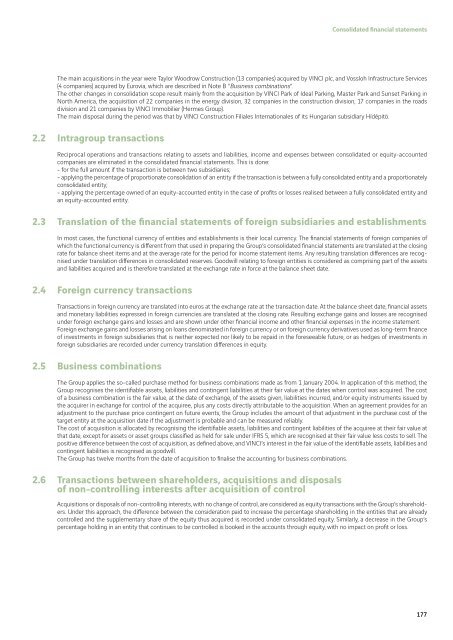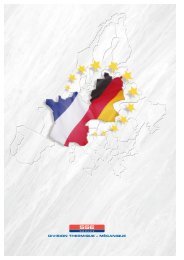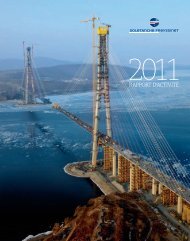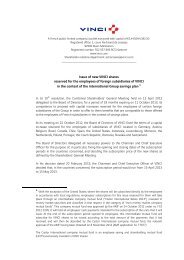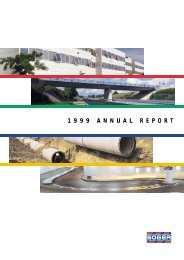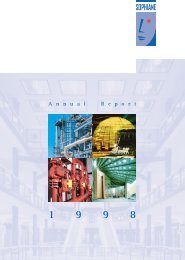VINCI - 2008 annual report
VINCI - 2008 annual report
VINCI - 2008 annual report
Create successful ePaper yourself
Turn your PDF publications into a flip-book with our unique Google optimized e-Paper software.
Consolidated fi nancial statements<br />
The main acquisitions in the year were Taylor Woodrow Construction (13 companies) acquired by <strong>VINCI</strong> plc, and Vossloh Infrastructure Services<br />
(4 companies) acquired by Eurovia, which are described in Note B “Business combinations”.<br />
The other changes in consolidation scope result mainly from the acquisition by <strong>VINCI</strong> Park of Ideal Parking, Master Park and Sunset Parking in<br />
North America, the acquisition of 22 companies in the energy division, 32 companies in the construction division, 17 companies in the roads<br />
division and 21 companies by <strong>VINCI</strong> Immobilier (Hermes Group).<br />
The main disposal during the period was that by <strong>VINCI</strong> Construction Filiales Internationales of its Hungarian subsidiary Hídépitö.<br />
2.2 Intragroup transactions<br />
Reciprocal operations and transactions relating to assets and liabilities, income and expenses between consolidated or equity-accounted<br />
companies are eliminated in the consolidated fi nancial statements. This is done:<br />
- for the full amount if the transaction is between two subsidiaries;<br />
- applying the percentage of proportionate consolidation of an entity if the transaction is between a fully consolidated entity and a proportionately<br />
consolidated entity;<br />
- applying the percentage owned of an equity-accounted entity in the case of profi ts or losses realised between a fully consolidated entity and<br />
an equity-accounted entity.<br />
2.3 Translation of the fi nancial statements of foreign subsidiaries and establishments<br />
In most cases, the functional currency of entities and establishments is their local currency. The fi nancial statements of foreign companies of<br />
which the functional currency is diff erent from that used in preparing the Group’s consolidated fi nancial statements are translated at the closing<br />
rate for balance sheet items and at the average rate for the period for income statement items. Any resulting translation diff erences are recognised<br />
under translation diff erences in consolidated reserves. Goodwill relating to foreign entities is considered as comprising part of the assets<br />
and liabilities acquired and is therefore translated at the exchange rate in force at the balance sheet date.<br />
2.4 Foreign currency transactions<br />
Transactions in foreign currency are translated into euros at the exchange rate at the transaction date. At the balance sheet date, fi nancial assets<br />
and monetary liabilities expressed in foreign currencies are translated at the closing rate. Resulting exchange gains and losses are recognised<br />
under foreign exchange gains and losses and are shown under other fi nancial income and other fi nancial expenses in the income statement.<br />
Foreign exchange gains and losses arising on loans denominated in foreign currency or on foreign currency derivatives used as long-term fi nance<br />
of investments in foreign subsidiaries that is neither expected nor likely to be repaid in the foreseeable future, or as hedges of investments in<br />
foreign subsidiaries are recorded under currency translation diff erences in equity.<br />
2.5 Business combinations<br />
The Group applies the so-called purchase method for business combinations made as from 1 January 2004. In application of this method, the<br />
Group recognises the identifi able assets, liabilities and contingent liabilities at their fair value at the dates when control was acquired. The cost<br />
of a business combination is the fair value, at the date of exchange, of the assets given, liabilities incurred, and/or equity instruments issued by<br />
the acquirer in exchange for control of the acquiree, plus any costs directly attributable to the acquisition. When an agreement provides for an<br />
adjustment to the purchase price contingent on future events, the Group includes the amount of that adjustment in the purchase cost of the<br />
target entity at the acquisition date if the adjustment is probable and can be measured reliably.<br />
The cost of acquisition is allocated by recognising the identifi able assets, liabilities and contingent liabilities of the acquiree at their fair value at<br />
that date, except for assets or asset groups classifi ed as held for sale under IFRS 5, which are recognised at their fair value less costs to sell. The<br />
positive diff erence between the cost of acquisition, as defi ned above, and <strong>VINCI</strong>’s interest in the fair value of the identifi able assets, liabilities and<br />
contingent liabilities is recognised as goodwill.<br />
The Group has twelve months from the date of acquisition to fi nalise the accounting for business combinations.<br />
2.6 Transactions between shareholders, acquisitions and disposals<br />
of non-controlling interests after acquisition of control<br />
Acquisitions or disposals of non-controlling interests, with no change of control, are considered as equity transactions with the Group’s shareholders.<br />
Under this approach, the diff erence between the consideration paid to increase the percentage shareholding in the entities that are already<br />
controlled and the supplementary share of the equity thus acquired is recorded under consolidated equity. Similarly, a decrease in the Group’s<br />
percentage holding in an entity that continues to be controlled is booked in the accounts through equity, with no impact on profi t or loss.<br />
177


